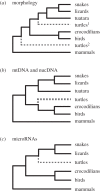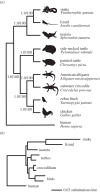More than 1000 ultraconserved elements provide evidence that turtles are the sister group of archosaurs
- PMID: 22593086
- PMCID: PMC3440978
- DOI: 10.1098/rsbl.2012.0331
More than 1000 ultraconserved elements provide evidence that turtles are the sister group of archosaurs
Abstract
We present the first genomic-scale analysis addressing the phylogenetic position of turtles, using over 1000 loci from representatives of all major reptile lineages including tuatara. Previously, studies of morphological traits positioned turtles either at the base of the reptile tree or with lizards, snakes and tuatara (lepidosaurs), whereas molecular analyses typically allied turtles with crocodiles and birds (archosaurs). A recent analysis of shared microRNA families found that turtles are more closely related to lepidosaurs. To test this hypothesis with data from many single-copy nuclear loci dispersed throughout the genome, we used sequence capture, high-throughput sequencing and published genomes to obtain sequences from 1145 ultraconserved elements (UCEs) and their variable flanking DNA. The resulting phylogeny provides overwhelming support for the hypothesis that turtles evolved from a common ancestor of birds and crocodilians, rejecting the hypothesized relationship between turtles and lepidosaurs.
Figures


Similar articles
-
Phylogenomic analyses support the position of turtles as the sister group of birds and crocodiles (Archosauria).BMC Biol. 2012 Jul 27;10:65. doi: 10.1186/1741-7007-10-65. BMC Biol. 2012. PMID: 22839781 Free PMC article.
-
MicroRNAs support a turtle + lizard clade.Biol Lett. 2012 Feb 23;8(1):104-7. doi: 10.1098/rsbl.2011.0477. Epub 2011 Jul 20. Biol Lett. 2012. PMID: 21775315 Free PMC article.
-
Toward consilience in reptile phylogeny: miRNAs support an archosaur, not lepidosaur, affinity for turtles.Evol Dev. 2014 Jul-Aug;16(4):189-96. doi: 10.1111/ede.12081. Epub 2014 May 5. Evol Dev. 2014. PMID: 24798503 Free PMC article.
-
The evolutionary position of turtles revised.Naturwissenschaften. 2001 May;88(5):193-200. doi: 10.1007/s001140100228. Naturwissenschaften. 2001. PMID: 11482432 Review.
-
Reptile genomes open the frontier for comparative analysis of amniote development and regeneration.Int J Dev Biol. 2014;58(10-12):863-71. doi: 10.1387/ijdb.140316kk. Int J Dev Biol. 2014. PMID: 26154326 Review.
Cited by
-
Functional trait mismatch between native and introduced bee pollinators servicing a global fruit crop.BMC Ecol Evol. 2024 Aug 2;24(1):104. doi: 10.1186/s12862-024-02293-4. BMC Ecol Evol. 2024. PMID: 39095704 Free PMC article.
-
The Evolution of Ultraconserved Elements in Vertebrates.Mol Biol Evol. 2024 Jul 3;41(7):msae146. doi: 10.1093/molbev/msae146. Mol Biol Evol. 2024. PMID: 39058500 Free PMC article.
-
Forelimb muscle activation patterns in American alligators: Insights into the evolution of limb posture and powered flight in archosaurs.J Anat. 2024 Jun;244(6):943-958. doi: 10.1111/joa.14011. Epub 2024 Jan 19. J Anat. 2024. PMID: 38242862 Free PMC article.
-
Multiple Routes to Color Convergence in a Radiation of Neotropical Poison Frogs.Syst Biol. 2023 Dec 30;72(6):1247-1261. doi: 10.1093/sysbio/syad051. Syst Biol. 2023. PMID: 37561391 Free PMC article.
-
Low hybridization temperatures improve target capture success of invertebrate loci: a case study of leaf-footed bugs (Hemiptera: Coreoidea).R Soc Open Sci. 2023 Jun 28;10(6):230307. doi: 10.1098/rsos.230307. eCollection 2023 Jun. R Soc Open Sci. 2023. PMID: 37388308 Free PMC article.
References
-
- Lee M. S. Y., Reeder T. W., Slowinski J. B., Lawson R. 2004. Resolving reptile relationships. In Assembling the tree of life (eds Cracraft J., Donoghue M. J.), pp. 451–467 Oxford, UK: Oxford University Press
-
- Lee M. 1997. Reptile relationships turn turtle. Nature 389, 245–24610.1038/38422 (doi:10.1038/38422) - DOI - DOI
-
- Rieppel O. 1999. Turtle origins. Science 283, 945–94610.1126/science.283.5404.945 (doi:10.1126/science.283.5404.945) - DOI - DOI - PubMed
-
- Janke A., Erpenbeck D., Nilsson M., Aranason U. 2001. The mitochondrial genomes of the iguana (Iguana iguana) and the caiman (Caiman crocodylus): implications for amniote phylogeny. Proc. R. Soc. Lond. B 268, 623–63110.1098/rspb.2000.1402 (doi:10.1098/rspb.2000.1402) - DOI - DOI - PMC - PubMed
-
- Hedges S., Poling L. 1999. A molecular phylogeny of reptiles. Science 283, 998–100110.1126/science.283.5404.998 (doi:10.1126/science.283.5404.998) - DOI - DOI - PubMed
Publication types
MeSH terms
Substances
LinkOut - more resources
Full Text Sources
Other Literature Sources


